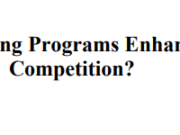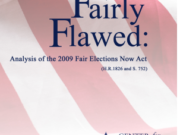On Friday, The New York Times Editorial Board resumed its delusional calls for a statewide taxpayer-financed campaign program, using long-discredited arguments to urge the Governor Cuomo-appointed Moreland Commission to make tax-financing its “No. 1 proposal” in a report on corruption in the state’s campaign and election systems, expected December 1.
The Editorial Board writes “most deep-pocketed donors cost the taxpayer dearly. They do so by demanding special treatment — enacting this law, undoing that one — in ways that benefit them, not all of us.” The Times does not support this claim with any research or reference to existing taxpayer-financing programs, and it’s easy to see why. The experience of actual tax-financing programs refutes its naïve argument.
Academic research has long acknowledged that campaign contributions do not buy floor votes, making The Times’ depiction of legislators acting at the behest of wealthy donors and “enacting this law, undoing that one” over-simplistic to the point of absurdity. Additionally, CCP’s own research into existing tax-financing programs in Arizona and Maine has consistently found that these programs do not save taxpayer dollars or reduce the growth of government spending, and do not reduce the number of lobbyists in a state. While The Times implies that tax-financing would free legislators from the influence of donors, a study of Connecticut’s taxpayer-funded program found that legislators were equally likely to vote with organized interests before and after tax-financing was implemented, and a Goldwater Institute study of Arizona’s program found no difference in voting behavior between candidates who used the tax-financing program and those who did not.
The Times’ claims simply aren’t based in reality. They don’t understand how money functions in politics, and they don’t know how taxpayer-financed campaigns operate in practice.
The editorial goes on to claim that tax-financed campaigns would make elections more competitive, stating that “Albany’s lawmakers fear that public financing of campaigns will encourage real challengers to run against them.” Yet an extensive 2010 GAO study of Arizona’s and Maine’s programs found that “there were no statistically significant differences observed for… contestedness (number of candidates per race) and incumbent reelection rates,” and concluded that the programs had no effect on voter choice, campaign spending, or the influence of interest groups. A CCP study of corruption in tax-financed campaign programs found repeated instances of candidates running for office simply to qualify for tax funds that are then used on personal expenses and in questionable ways. In fact, between 2001 and 2013 New York City provided over $19 million to candidates who were later investigated (and in many cases, convicted) for a disturbing variety of abuses. Candidates who fabricate campaigns to get their hands on the public’s money are anything but “real challengers” to the status quo.
Again, The Times appears ignorant of the large body of research on these programs and the role of money in politics. Its arguments might be fashionable in 1913, but they are outdated and discredited in 2013.
Ironically, The Times brushes aside the one definite truth about tax-funded campaign programs: they take taxpayer dollars away from other public priorities. Indeed, these programs are costly and likely to increase in cost over time. For example, New York City’s tax-financing program began by matching every $1 in small contributions with $1 in tax dollars. Today, a $1 contribution in New York City is matched by $6 in tax funds.
The Times urges Governor Cuomo to keep his vow to “clean up Albany,” but there’s nothing clean about forcing taxpayers to foot the bill for a politician’s campaign. The Moreland Commission would be wise to caution against this failed idea. At the very least, it should be debated on facts from the real world, not proclamations from The New York Times’ fantasyland.














